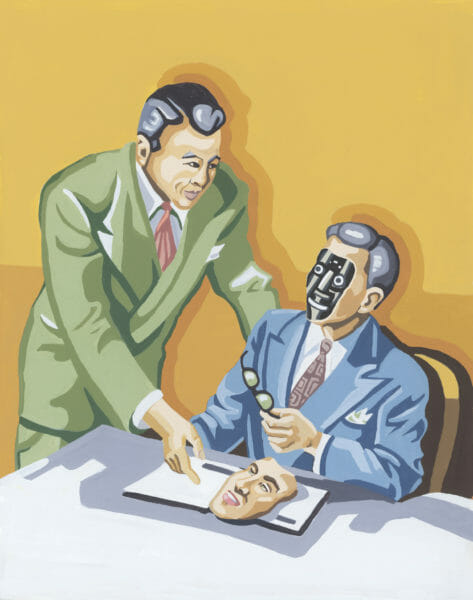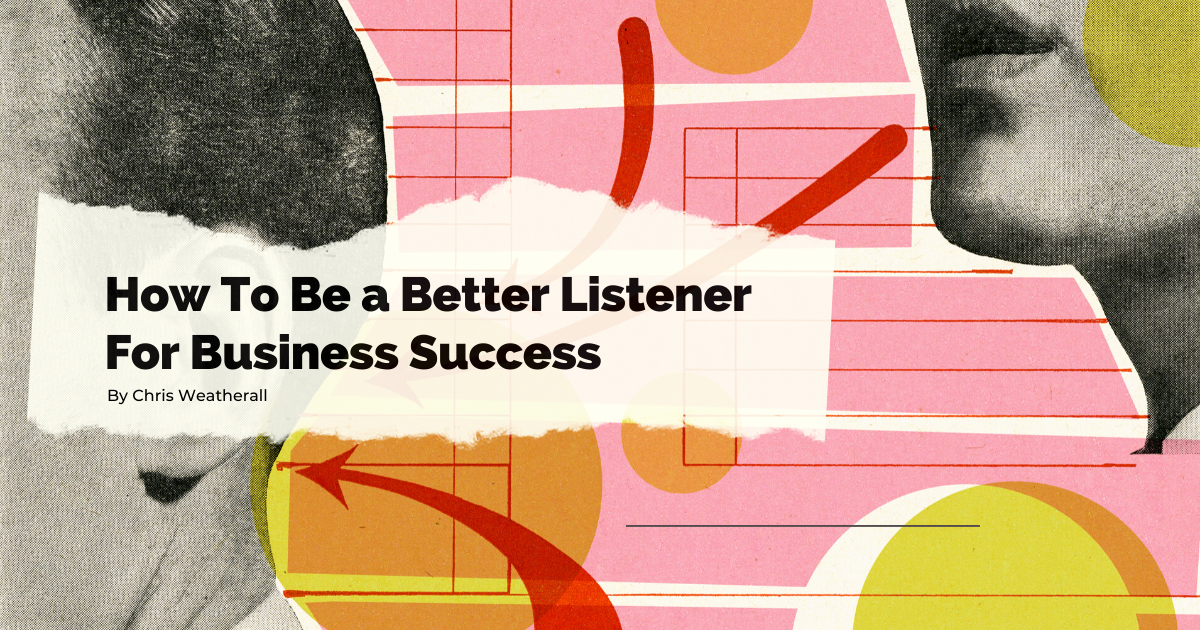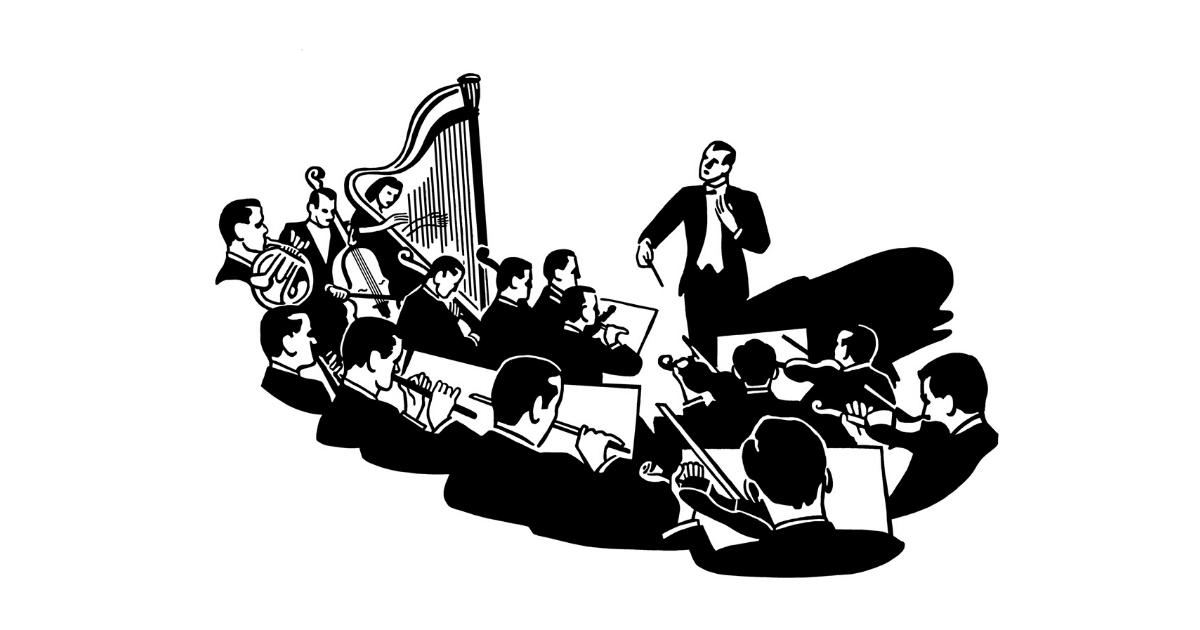Can You Become a Better Listener?
Our fascination with listening – or, more accurately, why we don’t listen – has long been the subject of fascination and rebuke. For example, in a 1957 interview by the Harvard Business Review, executives of a manufacturing plant in Chicago were asked questions about a recent seminar they attended on listening. One of the most prolific comments was:
“Frankly, I had never thought of listening as an important subject by itself. But now that I am aware of it, I think that perhaps 80% of my work depends on my listening to someone, or on someone else listening to me.”
The article goes on to say that many of these executives admitted that the lion’s share of mistakes – including workplace accidents – were the result of miscommunication or failure to listen.
Fast forward 60 years, and the problem has gotten exponentially worse. The human attention span is infamously less than a goldfish. One study found that half of adults could not describe the content of a short oral presentation (10 minutes), even moments after listening to it. After 48 hours, 75% of subjects couldn’t even tell you what the presentation was about.
Another survey of thousands of American workers revealed that we are too distracted to be good listeners. Nearly two thirds of respondents noted that listening has become more difficult as the world becomes more digital.
So, whose fault is it that we’re bad listeners? Technology? Our own laziness?

A little bit of both, with some biology mixed in.
Did you know, for example, that our brains can safely digest 400 words per minute? And did you know that even the fastest speakers can only give rapid fire dialogue around 125 words a minute?
What is the other 75% of your brainpower doing at that time? It’s bored. Hence, it tries to fill that space with other stimuli – emailing, surfing social media, catching up on other digital errands. And listening comprehension goes down.
This issue only becomes compounded with the convenience and demands of living in the digital age. Social media, for example, rewards people who make a lot of noise without listening. The rules of social media dictate that you should:
- Share a lot of stuff (multiple times a day!)
- You should publish your own stuff as much as possible
- When you share other people’s stuff, they share your stuff
- When you follow other people, they follow you
If you’re in marketing, you’re probably so used to peddling noise that you haven’t thought much about stopping and listening.
Which isn’t necessarily your fault.
Think about it.
When does anyone on social media get rewarded for digital listening? Commenters don’t get their share of the profits or traffic. There is no reward system for showing that you listen, unless it’s a “like.” All the rewards – both the intrinsic (dopamine rush) and extrinsic (profits, if you’re a marketer), go to the person who does the talking.
In this way, we are trained – even professionally – to not listen.
This applies to more than just marketing. As a society, we revere great speakers – if you look throughout history, some of the most highly regarded presidents (based on average approval rating) such as Kennedy, FDR, and Eisenhower – were great orators.
“The only thing we have to fear is fear itself.”
“Ask not what your country can do for you, ask what you can do for your country.”
These sayings have become part of the American cultural lexicon. Now, can you name three American leaders who are known for their penchant for listening?
Bring it down closer to home. How many of your work meetings involve everyone taking turns and digesting what everyone is saying – and how many of them are people talking over everyone else, eager to have their own voices heard? Why is this?
We Desire to Be Understood.
Humans are looking to be understood. That is, at least, a core argument in the book that made Steven Covey famous, The 7 Habits of Highly Effective People. In it, he says that most people have an intrinsic desire to be understood. This is the foundation of human connection. Unfortunately, in doing so, you may neglect the other party completely, pretending to listen but only hearing parts of the conversation, which can lead to misinterpretation of intent altogether.
Now, I know what you’re thinking. Here, you might be getting a little defensive and thinking “I’m a GREAT listener!” Maybe you even count good listening skills as one of your biggest assets.
Science says you might be wrong there, too. In fact, in a study about listening comprehension, only 18% of people could answer simple questions correctly about a dialogue.
Maybe you belong in the 18%. Maybe you think that you could easily repeat something back that someone told you. But that doesn’t make you a good listener.
It makes you a good hearer.
Hearing is the act of listening to noise; listening is deriving meaning from those noises. To be a good listener, you must interpret and understand what people are saying.
In other words, in modern society, what Simon and Garfunkel feared has come to pass: “People hearing without listening.”
How do we resolve that conundrum?
Hear my words that I might teach you:
Listening Is One of Our Most Meaningful Experiences.
Take a moment to consider how listening impacts our life and relationships.
A baby can cry and hasten the soothing touch and murmuring of her parents.
A lonely millennial in the midst of a professional crisis can hear a song on the radio and be instantly transported to a fond college memory.
An elderly patient in a nursing home can experience instant happiness at the sound of a friend or family member on the telephone. There is even some evidence that familiar music can trigger a lucid moment in a patient with Alzheimer’s.
Listening, when performed with understanding, forms the basis of some of the most precious moments and relationships. Who wouldn’t want to hone that skill for themselves – both professionally and personally?
Now, comes the bulk of this conversation: how can you become a better listener? How can you pivot from being a person who makes noise to a person who makes sense of the noise?
There are a lot of different tips we’re excited to share with you, but the bulk of it goes something like this: to become a good listener, you must be an active and engaged member of a conversation.
In a study published by the Harvard Business Review, two CEO’s analyzed the behavior of nearly 3,500 participants in a development seminar designed to make managers better coaches. Of this cohort, they identified the top 5% (who were deemed the best listeners) and asked others to describe what made them good listeners. The results were insightful:
- Good listening involves more than just being quiet while another person talks. In fact, many people interpret silence throughout talking as not paying attention. Rather, the best listeners are those who periodically ask questions that drive the conversation forward or promote insight. Nodding silently does not tell the speaker that the other party is listening; asking thought provoking questions tells the speaker not only that the other party is listening, but cares about what was said. Good listening, therefore, is active.
- Good listening does include interactions that help improve self-esteem. People who are deemed good listeners make the experience of having a conversation positive. Creating a safe environment, making a person feel supported, and conveying confidence in the other party were all tenets of good listening.
- Good listening could also be described as “cooperative conversation.” In other words, good listeners help make a conversation flow. Even when differences in opinion arise, a good listener will not put the other party on the defensive. By contrast, poor listeners are often perceived as competitive and wanting to win an argument.
- Good listeners tend to make suggestions. Finally, those perceived as good listeners provided feedback in a manner in which the other party was more likely to accept. Authors of the article found this surprising, as it is not uncommon to hear, “But they didn’t even listen, they just jumped in and tried to solve the problem themselves.” This tells us that execution in providing feedback matters.
In other words, don’t assume that being silent is the key to good listening, either.
Now, you might be thinking: Why is it important for me as a marketer to be a good listener? Aren’t I literally in the business of “making noise?”
Yes, you should make a little noise, but it is also essential to know how to listen. Here’s why:
When we listen to our customers, prospects, and readers, we can find innovative solutions to our business problems. For example, after hosting live customer interviews, Moz saw more than a 50% increase in conversions. Other practical applications of listening for business include:
- Refining or rediscovering your value proposition
- Discovering and targeting the most valuable viable audience
- Building and launching new products that will sell well
In a sense, you could argue that your job as a marketer is actually to listen. Know what your customers want. When you listen and understand a customer, prospect, or reader, you make a connection. And that connection does pay out dividends.
You have to know how to listen to do good marketing and copywriting. But how do you achieve that when you know that most of us are inherently bad listeners?
Let’s Start With The Basics of Being a Good Listener.
First, if you want to understand what is currently impeding your ability to be a good listener, do these three things.
- Put your phone on Airplane mode before engaging in a conversation with someone.
- Shut the door to the room where you are having the conversation.
- Focus solely on the conversation that is happening right there, where you are (yep, shut down your computer, too).
By doing these three simple things, you are already doing better. You’re prioritizing the speaker, minimizing distractions, and preparing what could become a meaningful conversation with a fellow human being.
Now, follow these eight tips to facilitate more meaningful conversations with your friends, customers, bosses, coworkers – you name it.
Tip #1: Ask Thought-Provoking Questions
Remember how we said that good listeners didn’t just stand silently by? Show that you are actively listening by periodically asking questions that drive the conversation forward.
Stuck for ideas? Just follow the example of four-year-olds: “Why?”
Asking for more detail does more than just fill silences. It also helps you drill down a customer/reader/prospects/coworker’s intent to a specific level.
Now, to be clear, don’t actually emulate a four-year-old and interject “but why?” at the end of every sentence. Rather, try strategically rephrasing parts of the conversation and asking to elaborate. For example, when talking to a colleague:
“I noticed you said that you like tracking metrics with [this tool]. Why is that?”
Now, you cannot drive a conversation forward by asking “why” alone. Asking intentional questions shows the speaker that you heard what they said, understood it, and want more detail.
Some examples of intentional questions include:
- How did that make you feel?
- Can you tell me more about that?
- Why do you think that is?
- I thought what you said about _______ was interesting. Can you elaborate on that?
Simply put, asking good questions makes you a better listener, better marketer, better friend, better spouse – you name it.
Tip #2: Be Empathetic
Empathy is a life skill, plain and simple. Like many other like skills, some people naturally have more of it than others. Even if you are not a naturally empathetic person, you can hone this skill over time.
Business is, at its most basic form, the act of meeting someone else’s needs. How else will you understand what those needs are without empathy?
Try to understand what your customer’s pain points and desires are – through their perspective. Not yours.
As you try to hone your empathy skills, you may find that you become naturally more curious about what your customers are experiencing. Curiosity is a part of what many experts call “generous listening.” Philosophy professor Milton Mayeroff describes generous listening in his book, On Caring:
“To care for another person, I must be able to understand him and his world as if I were inside it… I must be able to be with him in his world, ‘going’ into his world in order to see from ‘inside’ what life is like for him.”
Being curious about another person’s perspective is more than just good business – it frames good copywriting, it creates better UX, and forms healthier relationships, both professionally and personally.
Tip #3: Take Quality Notes
You might already be a meticulous notetaker. Most of us Type A people in marketing are. However, the nature of your note taking also matters. If you are jotting things down without understanding them and the insights they provide about other people, they’re pretty useless, no?

Sabina Nawaz, CEO and executive coach, recommends trying what she calls the Margin Note technique. Using this method allows you to make better connections, process information more effectively, and ultimately ask better questions to produce healthy conversation. It’s simple, yet effective. Here’s the gist:
- If using a digital document, set your pages with a wider margin than usual. In the body of your notes, you will only write down what the person is saying (go for larger themes as opposed to verbatim).
- On the other column, use the margin section to write down impressions, rebuttals, and questions that may arise from each of the points. In a literal sense, you have an opportunity to set your own voice aside and make space for the opinions of others.
Tip #4: Provide Recaps Throughout the Conversation
Time to bring out your amateur sports announcer. To occupy your restless mind, try restating a customer’s or users talking points as you go.
An infamous Harvard study using an iPhone app found that 50% of people who were supposed to be focused on a present task were actually doing something else.
If you’re in any kind of customer relations, this is not a good look.
One of the best ways to force your wandering mind back to the present is by restating their talking points. Double check their message and intent by using expressions like:
“What I am hearing you saying is….”
“Do you mean….?”
Over time, you’ll find that using this technique helps you:
- Process what other people are actually saying
- Pay attention to acknowledge a speaker’s feelings and intent
- Convey that you understand and hear the other person’s thoughts (which makes them feel more valued).
Want a simple transitional word for these conversations? According to a TED talk by Julian Treasure, that magic word is “So.”
Tip #5: Pay Attention to Non-Verbal Cues
Most of us know that communication is so much more than what we say. Crossed arms are a universal sign of defensiveness, for example.
In a world dominated by tools like texting messaging and Slack, it is understandable that we all could use a little work improving our deductive reasoning of body language. Most of us communicate through screens more than we do in person.
At the same time, it’s those little things – the twitch of an eyebrow, a shadow of a smile – that let us know what another person is thinking. Read more about body language cues.
Unfortunately, widespread use of devices has seriously impeded our ability to connect and read emotions. And it is starting to take its toll. A study published by UCLA found that sixth grade children – digital natives — who watched a video on silent and were asked to infer emotions scored miserably.
A note of good news however – when half of these children untethered from their devices for five days and went to a nature camp (where they had to have face-to-face interactions), their scores improved considerably.
What does this tell us? For one, devices are bad for our ability to discern intent. For another, that we can undo some of the damage by actually talking to one another. Weird, right?
Tip #6: Listen To The “Edges”
As humans, we are hardwired with a need to belong. This is one of the most extensively researched motivations in psychology and harkens back to our need to collaborate to survive.
Your customer, your target user, your prospect, your reader – they want to connect with you. Like all other humans, they want to be understood and embraced, even in little ways, throughout their day.
To truly understand a person, try listening to the “edges” of a conversation. These are the tiny details that, when combined, can spell the sum of a speaker’s intent. Edges can include:
- The pitch, ebb, and flow of a speaker’s voice
- Pauses in between words
- Lulls where a speaker might need a prompt to keep going
Note that patterns and where changes occur in a person’s manner of speaking. These are where the opportunities to connect arise.
Tip #7: Make a Conscious Effort to Quiet Your Mind
Be silent, be still. It seems like such a simple thing to do, but, in today’s bustling, technology-laden world, it’s actually difficult. One of the easiest ways to really experience silence is through meditation.
Meditation is not something that comes to most people naturally. Intrusive thoughts – “Am I doing this right?” “Is it working?” will inevitably occur. You can’t expect to master meditation the first time you try it. Keep working on it with the help of a beginner-friendly app like Headspace or Calm.
Then, try applying what you learned to listening – actually listening – to another person’s conversation. Be mindful, be in the moment.
Tip #8: Pay Attention to the Layers in the Noise
The next time you’re in a crowded space, like a restaurant during a dinner rush, take a moment to appreciate the activity that surrounds you.
There’s the clatter of dishes as a busy waitstaff clears plates. The sizzle of a steak as it hits a searing hot pan. Murmurs of conversation and a big belly laugh. These are the sounds of business, family, connection.
Listen in by dividing what you hear into sound layers. Acknowledge the impatient toddler wail at table 5 and the sound of a spoon swirling sugar into a coffee cup at the counter. When you practice identifying and appreciating these layers of sound, you will get better at turning some up, tuning some out, and focusing on what is most important to you. Like all other listening skills, this is something of an art form you fine-tune over time.
How else can you hone these abilities? Brown University auditory neuroscientist Seth Horowitz recommends:
- Listening to new, unfamiliar music
- Acknowledging your dog’s barks and whines
- Paying attention to the cadence and candor of your spouse’s voice
When you pay attention to the details in your world, your listening skills strengthen.
Putting It All Together
“I need to listen well so that I hear what is not said.” – Thuli Madonsela
So, the next time you have a conversation with a client, try applying the tips we have outlined above. Think about the intent of the customer, pay attention to details like body language and intonation, and use prompts and phrases to make sure they know you understand them. Being a great listener takes practice. However since communication is the root of all human connection, we would say that it is a journey well worth taking.






